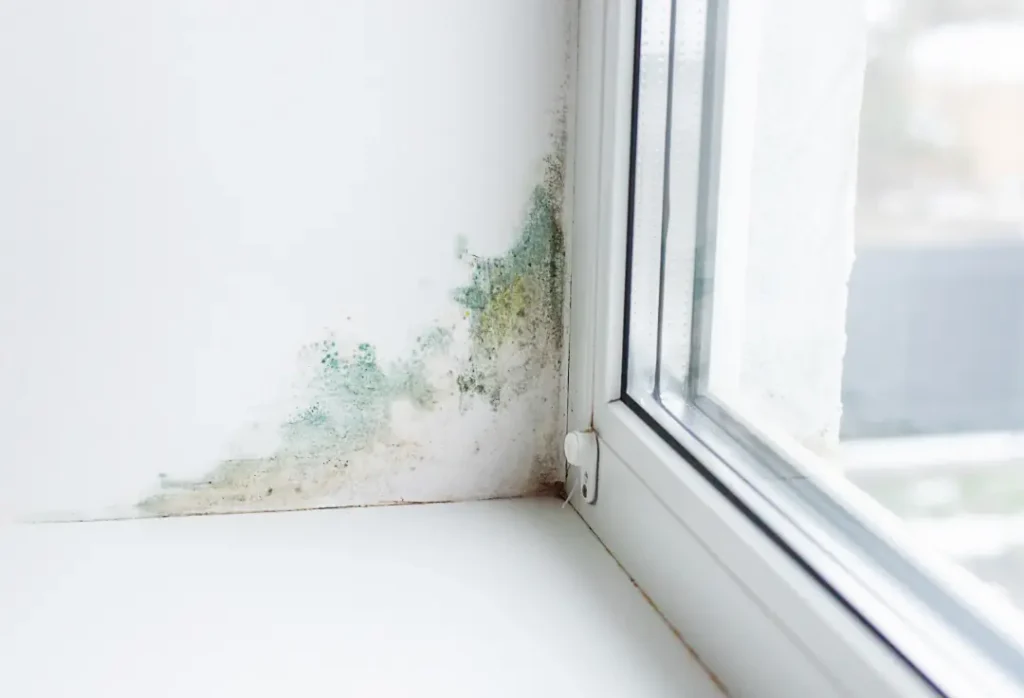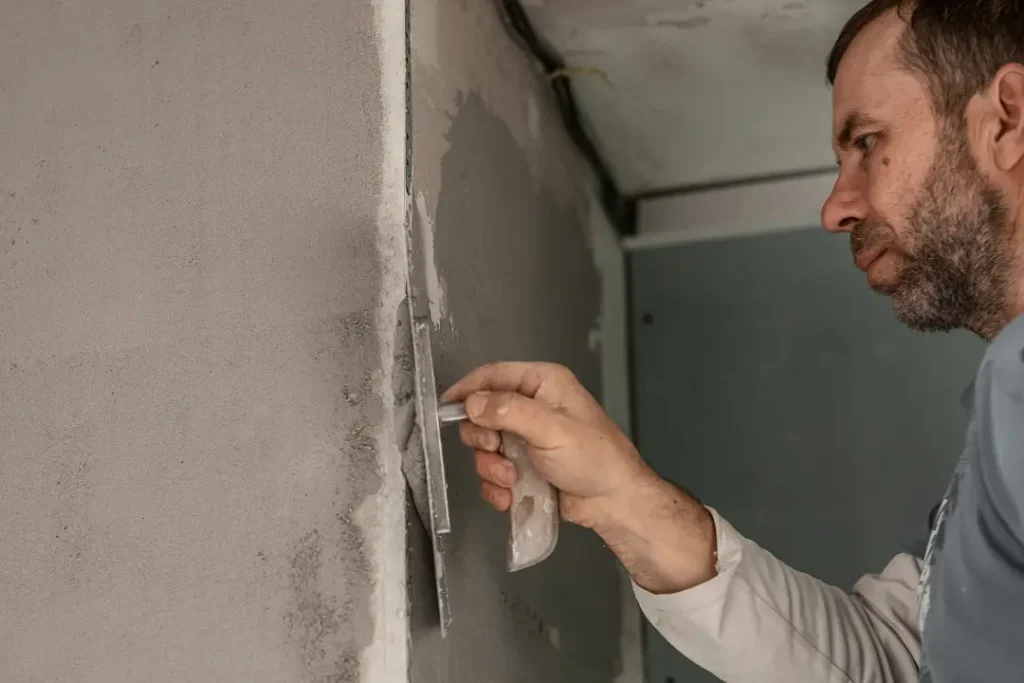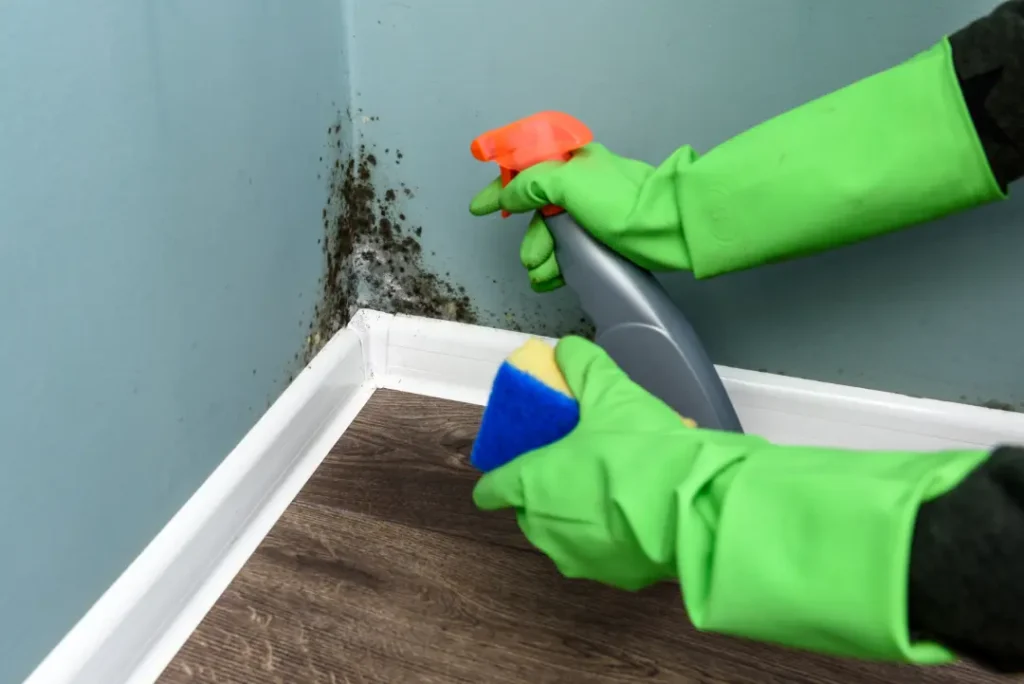Struggling with a musty smell in your home? The smell of mould is not just unpleasant; it can also be harmful.
This guide will teach you how to get rid of the smell of mould, from finding its source to removing it and preventing it from coming back.
Key Takeaways
- Mould emits microbial volatile organic compounds (MVOCs) that cause musty odours and negatively impact air quality.
- Identifying and addressing moisture sources, such as leaks and ventilation issues, is crucial for preventing mould growth.
- Professional help is recommended for extensive mould problems, especially when health risks or significant damage are involved.
Understanding Mould and Its Smell
Mould is more than just an unsightly nuisance; it can pose serious health risks and structural problems if left unchecked. Understanding what mould is and the reason behind its smell is crucial to combating it effectively.
Mould or mildew is a type of fungus that thrives in damp environments, producing spores that spread through the air. This is why you often notice musty smells in areas with high humidity or poor ventilation.

What is Mould?
Mould is a fungal growth that flourishes in damp, warm, and dark environments. It requires mould spores, a surface to grow on, oxygen, and moisture to thrive. Common sources of musty odours include basements, walls, spoiled food, and damp laundry. Checking areas like laundry hampers can help locate persistent musty smells.
While mildew is flat, mould is textured and raised, making it easier to identify.
Why Does Mould Smell Musty?
Moulds have a musty, sweet, or earthy smell. The musty smell associated with mould is due to the release of microbial volatile organic compounds (MVOCs). These MVOCs are gases emitted by mould and mildew as they grow. Mould emits over 200 types of MVOCs, each contributing to its distinctive musty odour.
These compounds not only create unpleasant smells but can also affect indoor air quality and health.
Health Risks of Mould Exposure
Exposure to mould can induce a variety of health issues, ranging from mild to severe. Common symptoms include nasal stuffiness, throat irritation, coughing, wheezing, and eye irritation. In more severe cases, individuals may experience headaches, dizziness, nausea, fatigue, and itchy skin or eyes.
People with allergies or asthma are particularly sensitive to mould exposure and may experience worsened symptoms and an increased risk of asthma attacks. Addressing mould promptly is key to maintaining a healthy living environment.
Identifying the Source of the Mould Smell
Identify the source of musty smells before attempting to remove them. Mould and mildew thrive in damp places, creating the musty smell often noticed in homes. These odours arise from moisture, humidity, and stagnant air, indicating a potential mould or mildew problem.
Persistent musty smells typically indicate active mould growth.
Common Areas to Check
Mould commonly grows in areas with high moisture levels, such as bathrooms, kitchens, basements, and poorly ventilated rooms. Bathrooms often harbour mould due to the high moisture levels from daily activities.
Kitchens are also prone to mould growth from food spills and moisture around sinks, especially if not cleaned regularly. Basements often have a musty smell and mould due to poor ventilation and low natural light conditions.
Visible Signs of Mould
Visible signs of mould can include discolouration on walls and ceilings. Damp patches on walls are another important indicator of potential mould issues.
Identifying these signs early can help you address the problem before it spreads further.
Using Your Nose
Your sense of smell can be a powerful tool for identifying musty odours in your home. Common causes of these house smells include damp laundry and a lack of air circulation in enclosed spaces. Check areas such as the laundry hamper and damp towels for musty odours to help locate the source of the smell.
Fixing Moisture Problems
Identifying and addressing the source of moisture is crucial for controlling mould issues. If mould growth is suspected to be hidden or extensive, expert evaluation is essential to avoid health risks.
Seek professional assistance for extensive mould issues or health risks. To maintain a mould-free environment, ensure proper airflow by keeping windows open and using ventilation systems.

Repair Water Leaks
Excess humidity can stem from plumbing leaks, which should be addressed immediately. Utilising moisture absorbers and mould-resistant coatings can help trap moisture and control mould growth.
Eliminating sources of moisture significantly reduces the risk of mould returning.
Improve Ventilation
Proper ventilation is essential for preventing mould growth. Open windows and doors, use ceiling and attic fans, and run the HVAC system to maintain airflow. Regular ventilation removes musty air and reduces moisture levels.
Increasing ventilation with fans, dehumidifiers, or simply opening windows can help reduce humidity levels.
Control Humidity Levels
To control mould growth, indoor humidity should be maintained below 50%. A hygrometer or humidity sensor can be used to measure humidity levels in a home. Dehumidifiers are effective devices to control humidity levels and prevent mould.
Effective air circulation and moisture management prevent mould and mildew growth.
Cleaning and Removing Mould
Once you’ve identified and addressed the moisture issues, it’s time to clean and remove the mould. Promptly clean small areas of mildew or mould and monitor the site. Use the same process for small areas as you would for mildew.
Throw away any mouldy absorbent or porous materials. Use detergent and water to scrub mould off hard surfaces. Ensure all affected areas are thoroughly cleaned.

Safety Precautions
Safety is paramount when cleaning moulds. Wear rubber gloves and a face mask to protect yourself from mould spores. Long gloves, goggles, and a respirator are recommended as protective gear when handling mould. Always ensure proper ventilation while cleaning mould to reduce inhalation risks.
Rags and sponges used to clean mould should be bagged and disposed of in outdoor garbage.
Natural Cleaning Solutions
Natural solutions can effectively remove mould. Distilled white vinegar can be used as a natural solution for cleaning mould. Diluted vinegar can be an effective option for removing mould in many cases.
These solutions are not only eco-friendly but also safe for use around children and pets.
Chemical Cleaners
Chemical cleaners might be necessary for larger areas of mould. An effective cleaning solution for moderate mould areas is 1 cup of chlorine bleach diluted in 1 gallon of water. The CDC recommends using 1 cup of laundry bleach per 1 gallon of water for cleaning mould.
Using an antifungal cleaner is an effective method to kill mould on surfaces. When using bleach for cleaning mould, do not mix it with ammonia to avoid dangerous fumes.
Preventing Future Mould Growth
Preventing future mould growth is essential to maintain a healthy living environment. Indoor humidity levels should ideally be maintained between 25% in winter and 50% in summer. Using exhaust fans in kitchens and bathrooms can significantly reduce moisture levels.
Regular cleaning and vacuuming in damp areas help prevent mould growth. A detailed cleaning of the home can eliminate dust, which is a potential source of musty smells.
Regular Deep Cleaning
Regular deep cleaning is crucial for preventing mould growth. Keeping areas free of dust and food debris is important. Dark and damp environments with moisture in closets and storage spaces are conducive to mould growth.
Areas that should be deep-cleaned regularly to prevent musty odours include carpets, rugs, showers, sinks, and damp corners.
Maintain Proper Ventilation
Maintaining proper ventilation is crucial for preventing mould and mildew growth in your home. Good air circulation helps remove spores and keeps surfaces dry, preventing mould.
Consistent use of ventilation systems and keeping windows open whenever possible significantly reduces the risk of mould regrowth in your home.
Use Mould-Inhibiting Products
Using mould-inhibiting products can provide long-lasting protection against mould. Mould-inhibiting paint is specifically designed to prevent the growth of mould and mildew on painted surfaces, providing long-lasting protection.
Moisture absorbers help maintain lower humidity levels, preventing mould growth. Common moisture absorbers include silica gel, calcium chloride, and activated charcoal, which can be placed in areas prone to dampness.
Deodorising Your Home
After tackling the mould itself, it’s time to deodorise your home. Eliminate musty odours by thoroughly cleaning and addressing the root cause—mould. Repair any leaks in the house to prevent musty odours.
Multiple cleaning options exist to eliminate musty odours and get rid of musty smells from clothes and other fabrics.
Air Purifiers
Air purifiers equipped with HEPA filters can eliminate up to 99.97% of airborne particles, including mould spores, thereby improving indoor air quality. The most effective air purifier for eliminating musty odours utilises HEPA filtration to capture these particles.
Models with activated carbon filters can absorb odours, making them suitable for improving indoor air quality in spaces affected by mould. Some air purifiers even come with built-in humidity control, which is crucial in preventing mould growth and musty odours.
Natural Odour Absorbers
Natural odour absorbers like activated charcoal or baking soda can effectively absorb musty odours in a home. To maintain their effectiveness, these substances should be replaced every two weeks.
Natural odour absorbers are a simple and eco-friendly way to help eliminate musty odours in your living spaces.
Fresh Air and Sunlight
Opening windows and doors regularly lets fresh air circulate, helping to remove stale odours caused by mould. Sunlight has natural antimicrobial properties, which can help reduce mould growth and neutralise musty odours.
Fans and exhaust systems significantly increase airflow and reduce humidity levels, discouraging mould growth. Regular deep cleaning and maintenance are essential for keeping areas dry and preventing the recurrence of mould and musty smells.
Professional Help
While DIY methods can be effective for minor mould issues, sometimes professional help is necessary. If you have extensive mould growth, structural damage, or health concerns, it’s time to call in the experts.
Recognising that mould problems can worsen over time prompts timely professional intervention. If you suspect you have black mould, consider calling in an expert. If the mould area exceeds 10 square feet, professional mould abatement becomes essential. This ensures the safe and effective removal of the mould.
If the job feels too overwhelming or there is extensive mould growth, hiring a mould cleanup specialist is the best course of action.
Protect Your Home from the Dangers of Damp with Environ Property Services
At Environ Property Services, we understand how damp and mould can disrupt your life and damage your home. That’s why we offer expert damp proofing solutions tailored to your property’s needs. Whether it’s rising damp, penetrating damp, or condensation issues, our team of specialists will ensure your home is protected from further damage and discomfort.
From initial surveys to implementing advanced damp treatments, our proven methods not only eliminate the problem but also prevent its recurrence. Protect your family’s health and the value of your home by choosing London’s most trusted damp proofing experts.
Comprehensive Services Backed by Integrity
We offer transparent, high-quality damp proofing services with no hidden surprises. Our team conducts thorough inspections, provides clear evidence of the problem, and discusses all options with you before any work begins. You’ll always know exactly what’s happening and why.
Beyond damp proofing, our skilled professionals handle related services such as plastering, plumbing, and repairs, ensuring your home is fully restored to its best condition. When you choose Environ Property Services, you’re choosing a partner who values your trust and satisfaction above all.
Proven Solutions for Peace of Mind
With products sourced from Sovereign, a world-class provider with Royal Family endorsements. Our London damp proofing services are covered by Sovereign guarantees, which last from 15 to 25 years. We combine this premium quality with competitive pricing, making reliable damp proofing accessible for every London home.
Don’t let mould and damp affect your quality of life. Contact Environ Property Services today for a professional survey and tailored solution. Call us at 0203 935 1596 and reclaim your home from damp, mould, and worry.
Frequently Asked Questions
What kills the smell of mould?
Using an air purifier effectively kills the smell of mould by removing moisture and allergens from the air. An air purifier is a practical and efficient solution for persistent damp odours.
What are the common areas where mould grows in a home?
Mould commonly grows in bathrooms, kitchens, basements, and poorly ventilated rooms due to high moisture levels. Addressing humidity in these areas is essential to prevent mould issues.
How can I identify mould in my home?
To identify mould in your home, check for visible discolouration on walls and ceilings, as well as damp patches. Pay attention to musty odours, which can also indicate the presence of mould.
How can I prevent mould from growing in the future?
To prevent mould from growing in the future, keep indoor humidity levels between 25% and 50%, use exhaust fans in kitchens and bathrooms, and regularly clean damp areas. For long-term protection, consider professional damp proofing solutions by Environ Property Services to address underlying moisture problems and create a mould-resistant environment.
Conclusion
Eliminating musty odours from your home involves understanding the nature of mould, identifying its source, fixing moisture problems, and thoroughly cleaning the affected areas. Preventing future mould growth requires regular deep cleaning, maintaining proper ventilation, and using mould-inhibiting products. Deodorising your home with air purifiers and natural odour absorbers can help maintain a fresh environment.
By following these steps, you can ensure a healthier living space, remove musty smells and lingering odours as well as eliminate the potential health risks associated with mould. Remember, a mould-free home is not just about cleanliness; it’s about creating a safe and pleasant environment for you and your family. Take action today and enjoy a fresher, healthier home.

